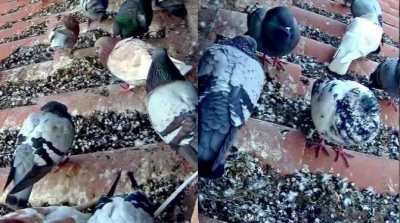As we enter 2019 some things have changed – we are currently updating the website of Bristol-based Good Riddance Pest Control to make it part of the Cleankill family – and some things stay the same – the need to protect your property from birds.
Normally we remind people about the dangers of bird pests just before they start nesting in late winter/early spring. This year, however, a terrible story from Glasgow's Queen Elizabeth University Hospital has reminded us of the dangers of letting birds into your property. Two patients at the hospital are reported to have died after contracting a cryptococcus fungal infection. While the cause of the infection is being investigated and a definitive source has yet to be identified, this contagion is associated with pigeon droppings and an area that was off-limits to the general public, a machine room, was found to be contaminated.
Whether pigeons are ultimately to blame for these unfortunate deaths, this is a timely reminder of the threat of nuisance flying pests, such as pigeons, gulls, and parakeets. It is important to make sure your home or business is protected from these flying invaders.
Before I go any further, it must be made clear, some birds, for example sparrows and starlings, are protected by law. Their numbers are dwindling. While you may think the murmurations of starlings you see are huge, in fact they are tiny in comparison to a few years ago. Personally, I remember massive murmurations of starlings when I was growing up.
Under the Wildlife and Countryside Act, it is an offence to kill, injure or interfere with wild birds. If you find they are causing you a problem, and flocks of birds can leave large amounts of faecal matter, you need to contact a professional pest controller. They can advise and assess what control sanctions can legally be put in place.
A more unusual problem we are increasingly seeing in the South-east are parakeets. Ring-necked parakeets have strong beaks and, when they enter loft spaces, can eat through exposed beams and rafters. They are also very clever and can use vents to access your property. Read our case study to learn more.
Parakeets are listed as agricultural and horticultural pests by Natural England, since 2010, but are still legally protected as wild birds. It is therefore illegal to interfere or harm them, except under licence.
So, what are your options if you have a bird problem?
There are two basic approaches – scaring and hindering. If a pest bird thinks a perch is unsafe, it will move somewhere else; if it can’t access a building, it will move somewhere else.
For the last few years we have been using bird-free gel at several sites. This innovative product reflects ultraviolet light. To the birds, this looks like flames emanating from the pot, and it deters them from perching close to it.
It is applied in 8 mm deep dishes that can be hidden from view. This makes bird-free gel the ideal solution for listed buildings and properties where people don’t want to see spikes or netting. A case in point, in 2015 we used them to discourage pigeons from defacing a statue of Jesus in Uckfield, East Sussex. Other companies had failed in their attempts to stop pigeon droppings spoiling the statue, and the church wardens naturally didn’t want to cover their Jesus in netting – bird-free gel did the trick.
The gel remains effective for a minimum of two years, and even when it turns black, it still appears to remain effective. We’ve seen examples where the gel has been doing its work for even longer. In one case, at an interior design shop in Bishop’s Stortford, the gel is still working effectively after five years!
Another method we use to scare away pest birds is by using our feathered team member called Luna. Luna is a fully trained Harris Hawk who became part of our team in 2018. This is natural pest control at its very best. Pest birds see Luna as a predator and so they quickly leave the area. The amazing thing is, the effect doesn’t disappear as soon as Luna leaves the sight. This is another ideal method for properties where the owner doesn’t want netting or spikes.
I’m pleased to say at the start of 2019 Luna was joined by another Harris Hawk, Phoebe. More about her soon!
The final weapon in our arsenal is bird-proofing. Any professional pest control company should be able to offer you a proper inspection service that will identify weak areas and possible solutions. These might include netting, sprung wire systems and bird spikes. It might also include bird-free gel.
A note of caution, dealing with birds and their mess can be dangerous. You should always make sure your pest controller has proper insurance, has appropriate health and safety procedures in place, and is licensed to remove waste. Ideally, they should also be members of the British Pest Control Association.
If you want to see an example of how much waste can be produced, look at this video I posted in 2018.
As this awful story in Scotland shows, having nesting birds on your property can be dangerous. Don’t forget – pigeons carry more diseases than rats – it makes sense to ensure your property is properly protected.
We offer a comprehensive range of services to keep your property bird pest free. For more information, contact us on:
- Cleankill Pest Control – 0333 9203889 or info@cleankill.co.uk
- Good Riddance Pest Control – 0117 9000335 or info@grpestcontrol.co.uk
